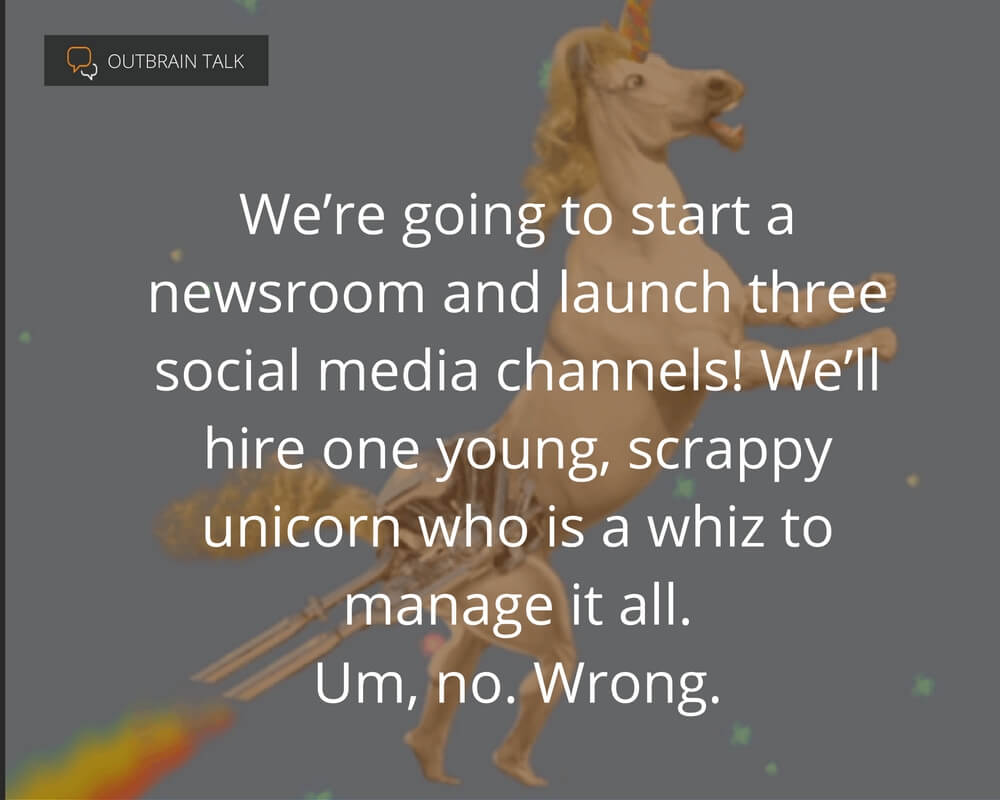5 Common Content Marketing Myths [And Why We Risk Burn-Out]
Anyone who has ever worked in the newspaper industry can instantly relate to John Oliver’s recent rant on the demise of print journalism. Indeed, for every journalist who has landed a cush content marketing or content strategy job, there’s the story of another who transitioned into a career as an Uber driver.
I started my career in book publishing and I definitely witnessed the same trajectory in that industry. Even before Penguin and Random House merged, I lived through the combination of Harcourt with Houghton Mifflin – and watched the subsequent layoffs.
And now, through my journalist husband and many close friends, I also feel the impact of the newspaper industry downsizing. I hear complaints about more work, but more proofreader cuts. I hear about writers who are obligated to focus on building their social platforms as much as they are forced to break great stories.
And yet, while I’ve certainly observed these changes from the privileged vantage point of my content marketing and strategy jobs, I still see some overlaps in our positions. Yes, I know – content marketers? Aren’t we the ones suggesting the “cat racoon” gifs and ruining journalism?
Content Marketing Newsrooms Take Work
Well, yes, and no. While branded content may be having a moment, as many of us can tell you, it is still undervalued and misunderstood. While our work may not be world-changing, like the newspaper journalists that Marty Barons discusses in John Oliver’s segment, the workload for content marketers is widening as well. In addition to writing articles, we have to participate in social media, create videos and infographics rapidly, juggle dozens of different stakeholder approvals, and, in many cases, manage and edit a staff of freelancers.
In the end, building a newsroom – any kind of newsroom – is a lot of work. And frequently the brands who want one, don’t seem to get it. Don’t just take it from me – many of the journalists who have found solace in our corner will tell you the same.
Here are just some of the common myths that I’ve had to figure out how to dispel in 10+ years in content marketing. (Oh yeah, and because we do specialize in the art of the “cat racoon gif” terrain, here are some complementary gifs for each one.)
Myth #1: One Person Can Do it All

We’re going to make white papers, e-books, videos, a website, an active blog, and launch three social media channels! No problem. We’ll hire for one junior position — we’ll find a young, scrappy unicorn who is a whiz to manage it all.
Um, no. Wrong.
One person can’t feasibly do all of these things. And if they can keep up, it isn’t going to look so great.
Reality check – our current newspaper newsrooms are barely keeping their heads above water and they have a team. Don’t expect to create all this content without resources. And moreover, don’t expect to be able to just start up your newsroom based on a couple of articles you read in Content Marketing Institute. The reality is totally different. Hire someone with experience building a team, creating an editorial calendar, and allocating budget and resources, who has done it before.
Myth #2: Good Writers are a Dime a Dozen

No, they are not. Just because your friend has a blog, doesn’t mean they should be writing for you. Weeding out the good and the bad takes a lot of work. Every writer you bring on requires training – on your strategy, your goals, and your product or service.
New writers, even if they are good, also require a lot of editing when you first bring them on. If they are not so good – forget it. In the time it takes to edit their blog post, your editor could have written three great articles.
That’s also why it is so important to compensate your writers – and to not shortchange them. Once you get a good writer in, you absolutely need to hang on to them. Additionally, don’t forget, these days, very frequently you are paying for a writer’s time, byline, and social media audience. And if you aren’t paying for their byline and they are ghostwriting for you, you need to compensate them even more, because they are getting very little out of the experience.
Myth #3: We’ll Buy a Bunch of Data Tools and That Will Solve Everything!

Yes, these days, we are at the advantage of having tons of ways to measure the success of our content and a ton of tools to distribute content. While tools are great, don’t forget that we need to invest a lot of time into setting them up and making them work for us. Additionally, while tools may load us with a ton of new and helpful data at our disposal, very frequently we don’t even have the time to use it, because we’re just trying to keep our head above water. Which gets me to point number four…
Myth #4: More Content is Better

Why are we creating all this content again? Doesn’t it make sense to focus on quality vs. quantity and actually amplify the content we produce? Wouldn’t it make sense to be able to take the time to measure our successes – and failures – and adjust accordingly. Before we decide we want a newsroom, let’s be realistic and look at our resources, our tools, and how our content is performing and plan how to scale up slowly and effectively.
Myth #5: If You Build it, They Will Come

This idea that by simply producing content you get mass amounts of engaged audiences that automatically convert and drive business is not a reality. Content marketing is a long game and there’s a lot of nurturing involved. In fact, this is the value prop of content marketing – to establish meaningful relationships with audiences that eventually lead to consumer decisions with a brand.
What Next?
So, as content marketers, how do we dispel these myths and continue to fight for the time and resources to do good work? How do we vocalize this in a way to our team member and decision-makers that can’t be reduced to just whining and brattiness?
For me, it has always been a mix of education and collaboration. It was literally running around my agency for three-and-a-half years with a “what is content strategy” deck in my hands featuring case study successes and failures. It was also making sure that any kind of process plan detailed all the steps involved in a way that was transparent and available for all to see. Other times, it was using agile methodologies like retrospectives to see where our team went wrong or card rating exercises so team members from other disciplines could better empathize with the difficulty of a specific task. It always involved a lot of collaborative work sessions and detailed process flows.
In the end, it was a slow war of attrition and it wasn’t won easily. In fact, just as I’m guessing all of you are, I’m still working on it now.


